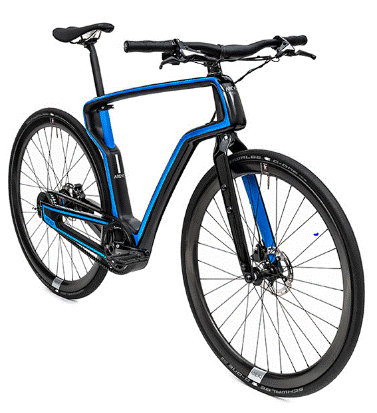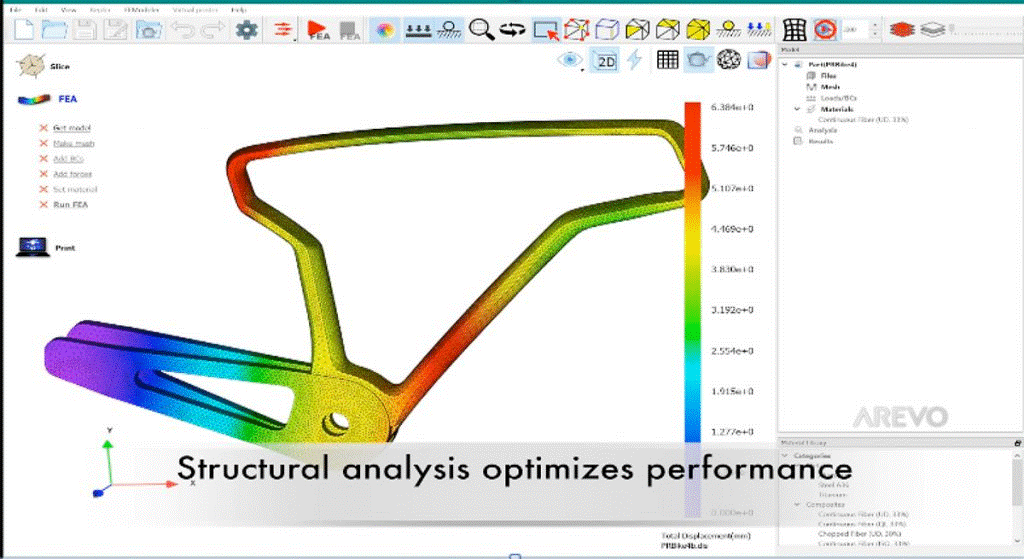

Bicycle design and production, like pretty much everything else these days, is being impacted by new technologies. Digital design tools, robotics, additive manufacturing (3D printing), and material science now enable new, exciting, and some surprising bike concepts, including essentially customized frames at down-to-earth prices.
As any good bicycle shop employee will tell you, good bike fit and geometry are the keys to handling, stability, performance, and comfort. That’s why high-end bike manufacturers offer their different models in a variety of geometries and sizes. “Skinny tire” road bikes, for example, can range from full-on racing geometries that place the rider low down over the handlebar to reduce aerodynamic drag, to more relaxed “sport” geometries that provide the rider with a less aerodynamically efficient, but far more comfortable, semi-upright position.

Bike geometry is determined by the respective lengths and angles of the top tube, head tubes, chain stays, front fork, handlebar drops, and so on. The fit can be further fine-tuned by adjusting the position of both the seat post and head tube for the individual rider.
In addition to bike size and frame geometry, the material(s) that the bike frame and fork are made of contribute significantly to the bike weight, strength, stiffness, and handling characteristics.
At one time or another, most serious bike riders have probably given some thought to having a custom bike made for them; one tailored specifically for their physical dimensions and riding styles using their preferred materials, typically steel, aluminum, titanium, or carbon fiber. Each material has its own strengths and weaknesses.
Well-designed steel bikes, for example, tend to be strong and comfortable (steel absorbs, rather than transmits most road shocks); but also heavier than the other materials. Aluminum bikes tend to be lighter than steel bikes, but aluminum also tends to transmit vibrations directly to the rider and thus aluminum bikes are not as comfortable in this respect than steel bikes. While the tube design of well-made aluminum bikes (such as my own trusty Cannondale road bike…) minimize this affect, it is still noticeable...particularly on those longer rides on today’s less-than-smooth roadways. And while titanium bike frames were once all the rage due to that material’s excellent strength-to-weight ratio, they also tend to be very unforgiving when it comes to transmitting road shocks to the rider. In the past at least, titanium bikes were also much more expensive than either steel or aluminum bikes.
Which finally brings us to carbon fiber.
Well-engineered and constructed carbon fiber bikes combine lightness, strength, and stiffness, while still doing a good job of absorbing road shocks. But they’re also time-consuming to make and require a high degree of craftsmanship and hand labor. This makes them expensive and thus out of reach for most bike riders.
But Arevo, a Silicon Valley start-up company, hopes to change all that with the world’s first carbon fiber bike produced using digital design, robotics, and additive manufacturing. Arevo is using the bike to demonstrate its design software, robotics-enable 3D printing technology, and composite carbon fiber material science. While still in the prototype stage, the company is looking to partner with an established bike company to move quickly into manufacturing. The company also has plans to extend this disruptive technology to help design and manufacture a whole range of products in which lightweight, high-strength composites could replace metal parts, such as aircraft and space vehicles. This is possibly why (according to an article in FORBES magazine) the CIA’s venture capital arm is one of the company’s several backers.
An article in a recent issue of BICYCLING magazine sums up this manufacturing application nicely:
“Traditional carbon-composite manufacturing is notoriously labor-intensive, requiring human assembly and expert precision. Some high-end frames can have as many as 500 individual pieces of carbon fiber. Arevo’s process differs in both construction technique and materials. Instead of laying down plies of fabric in a mold, a printer head mounted on a [multi-axis] robotic arm lays down carbon-fiber filaments, swiveling to orient them into a full bike frame. The filaments are continuous carbon fiber – not the short, chopped fiber used to make parts like pedal bodies – which might be Arevo’s biggest manufacturing breakthrough [for this application]…The resin is different too. Instead of a thermoset construction like conventional carbon fiber, Arevo’s composite includes a thermoplastic called PEEK (polyether ether ketone).” Many readers of this blog will be familiar with PEEK, since it is used in a variety of plant applications, including industrial sensors.
Arevo is particularly proud of the digital design engineering software it has developed to complement and take full advantage of its advancements in both materials science and multi-axis, robotics-enabled 3D printing. According to the company, in addition to dramatically reducing the time it takes to design a new bike (or anything else), the software uses a lifecycle approach. This includes design and structural analysis, generating the toolpath for the robotic 3D printing arm from the CAD model, providing simulation to verify manufacturability, and finally – post-manufacturing parts management to help optimize the digital supply chain. The company’s description of its engineering approach demonstrates a reasonably good grasp of the basic design engineering problem:
“While digitization has enabled the quick rendering of beautiful designs, ideas are still being squashed when bits meet atoms…Design-for-Manufacturing (DFM) was touted as a wonderful tool to bridge the gap between the two worlds, but what it actually did was simply codify manufacturing limitations earlier in the process, thus creating even more constraints and barriers to design freedom.”
And while this is certainly not the first time that ARC has heard similar claims, Arevo claims to be changing this paradigm by “eliminating the constraints of traditional manufacturing, giving designers unprecedented freedom to unlock the unparalleled strength, weight and economics of composite materials.”
While this is not mentioned in that article, hypothetically at least, the software could be employed to use additive manufacturing to 3D print one-off (“batch of one”) carbon fiber bikes for an individual rider in far less time and potentially at far less cost than is currently possible. Readers should note that while this certainly appears to be disruptive manufacturing technology, the commercial viability of 3D-printed carbon fiber bikes has yet to be demonstrated.


Arevo is not the only company looking to disrupt bike production with additive manufacturing.
For example, Renishaw, which claims to be the UK’s only manufacturer of a metal-based additive manufacturing machine that prints metal parts, has collaborated with a leading British design and manufacturing company to print what it believes to be the world first 3D-printed metal bike frame.
And, now, get this. According to an article I came across in FAST COMPANY (where else?), a group of London-based designers that call themselves the “Bamboo Bicycle Club, is prototyping a new system that uses a small 3D printer to make strong, custom lugs; the critical fittings that hold a bike’s frame tube together and largely determine its geometry. The idea here is that home builders could combine these 3D-printed lugs with about $20 worth of bamboo, to create their own custom DIY bike frames. “You could probably do the whole thing for $200, maybe $150,” according to club member, James Marr. “That’s to your own measurements, your own specifications, which to most cyclists is kind of the holy grail.”
The designers like bamboo for a few reasons. They believe it can compete with carbon fiber in terms of performance, but is better for the environment. And unlike a metal frame, it’s possible to put bamboo together without welding, so anyone could potentially do it at home.

